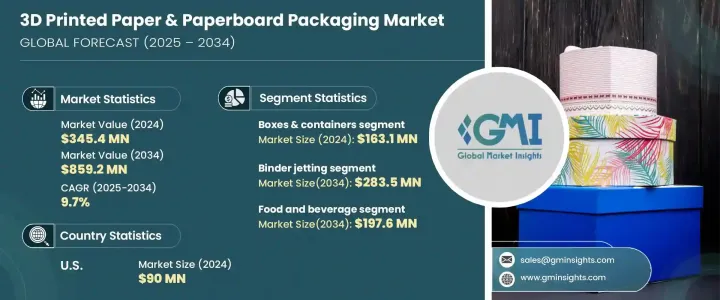
세계의 3D 인쇄지·판지 포장 시장은 2024년에 3억 4,540만 달러를 창출하며, 2025-2034년에 CAGR 9.7%로 성장할 것으로 예측됩니다.
이러한 급격한 성장은 개인화되고 독특한 포장 솔루션에 대한 소비자 수요 증가와 같은 몇 가지 중요한 요인에 기인합니다. 소비자의 취향이 진화함에 따라 기업은 이러한 수요 증가에 대응하기 위해 3D 프린팅과 같은 혁신적인 기술로 눈을 돌리고 있으며, 3D 프린팅은 기능적이고 사용자 정의 가능한 포장을 다양하고 효율적으로 제조할 수 있는 방법을 제공하여 경쟁 시장에서 차별화를 꾀하는 업계에서 매력적인 선택지가 되고 있습니다. 경쟁 시장에서 차별화를 꾀하는 업계에게 매력적인 선택지를 만들어 내고 있습니다.

환경 의식 또한 이 시장 확대의 주요 요인 중 하나입니다. 소비자와 기업 모두 지속가능성이 업계 전반에 걸쳐 지속적으로 우선순위를 차지함에 따라 친환경 솔루션으로 전환하고 있으며, 3D 프린팅된 종이 및 판지 포장은 기존의 플라스틱 포장에 대한 친환경적인 대안을 제공합니다. 이러한 지속가능한 재료는 생분해성 및 재활용이 가능하며, 재료 폐기물을 줄이는 데 도움이 되므로 고객에게 보다 친환경적인 포장 옵션을 제공하면서 보다 엄격한 지속가능성 규제를 충족하기 위해 노력하는 기업에게 매력적인 선택이 될 수 있습니다. 그 결과, 3D 인쇄된 종이 및 판지 포장은 환경에 미치는 영향이 주요 관심사인 분야에서 인기를 얻고 있습니다.
| 시장 범위 | |
|---|---|
| 시작연도 | 2024년 |
| 예측연도 | 2025-2034년 |
| 시작 금액 | 3억 4,540만 달러 |
| 예상 금액 | 8억 5,920만 달러 |
| CAGR | 9.7% |
시장은 박스 및 용기, 인서트 및 디바이더, 디스펜싱 제품 등 여러 주요 포장 부문으로 나뉘며, 2024년에는 박스 및 용기 부문이 1억 6,310만 달러 규모로 시장을 주도할 것으로 예측됩니다. 식품, 소매 등 다양한 산업에 걸쳐 있습니다. 기업이 플라스틱 폐기물을 최소화해야 한다는 압박에 직면하고 있는 가운데, 3D 프린팅 판지 포장은 지속가능하고 고품질의 맞춤형 대안을 제공합니다. 이 경량 솔루션은 기업이 포장 폐기물을 줄이면서 배송 및 제품 보관에 필요한 내구성과 기능성을 제공하면서 포장 폐기물을 줄일 수 있도록 돕습니다.
인쇄 기술은 시장을 형성하는 중요한 요소입니다. 종이 및 판지 포장 제조에는 바인더젯팅, 적층제조(LOM), 잉크젯 3D 프린팅, 폴리젯 프린팅 등 여러 3D 프린팅 기술이 활용되고 있습니다. 그 중에서도 바인더젯팅은 큰 성장이 예상되며, 2034년까지 2억 8,350만 달러의 매출을 창출할 것으로 예측됩니다. 바인더젯팅은 재료의 낭비를 최소화하면서 복잡한 맞춤형 포장 디자인을 신속하게 제조하고, 견고하고 가벼운 포장 구조를 제공하는 능력으로 인해 특히 선호되고 있습니다.
미국에서는 2024년 3D 인쇄용지 및 판지 포장 시장이 9,000만 달러로 평가되었습니다. 이 시장의 급격한 성장은 포장 분야의 지속가능성에 대한 관심이 높아졌기 때문으로 분석됩니다. 미국에서는 점점 더 많은 기업이 3D 프린팅 기술을 채택하여 지속가능성뿐만 아니라 에너지 효율성이 높은 포장 솔루션을 개발하고 있습니다. 이 최첨단 접근 방식은 보다 정밀한 생산을 가능하게 하고, 재료 낭비를 줄이며, 포장 설계가 제품에 더 적합하게 만들어 줍니다. 이는 운송 비용 절감과 배출량 감소로 이어져 미국 기업에게 3D 프린팅 포장이 더욱 매력적으로 다가올 수 있습니다.
The Global 3D Printed Paper & Paperboard Packaging Market generated USD 345.4 million in 2024 and is projected to grow at a CAGR of 9.7% from 2025 to 2034. This rapid growth is driven by several key factors, including the increasing consumer demand for personalized, unique packaging solutions. As consumer preferences evolve, businesses are turning to innovative technologies like 3D printing to meet these growing demands. 3D printing offers a versatile, efficient way to produce packaging that is both functional and customizable, creating an attractive option for industries seeking to differentiate themselves in competitive markets.

Environmental awareness is another major driver of this market's expansion. Consumers and businesses alike are shifting toward eco-friendly solutions as sustainability continues to be a priority across industries. 3D printed paper and paperboard packaging provide an environmentally responsible alternative to traditional plastic options. These sustainable materials are biodegradable, and recyclable, and help reduce material waste, making them an attractive choice for companies striving to meet stricter sustainability regulations while delivering greener packaging options to their customers. As a result, 3D printed paper and paperboard packaging is becoming increasingly popular in sectors where environmental impact is a primary concern.
| Market Scope | |
|---|---|
| Start Year | 2024 |
| Forecast Year | 2025-2034 |
| Start Value | $345.4 Million |
| Forecast Value | $859.2 Million |
| CAGR | 9.7% |
The market is divided into several key packaging segments, including boxes and containers, inserts and dividers, and dispensing products. In 2024, the boxes and containers segment led the market with a valuation of USD 163.1 million. The growing demand for 3D printed boxes and containers spans across industries like e-commerce, food and beverage, and retail. As businesses face increased pressure to minimize plastic waste, 3D printed paperboard packaging offers a sustainable, high-quality, and customizable alternative. This lightweight solution helps companies reduce packaging waste while delivering the durability and functionality required for shipping and product storage.
Printing technology is a critical factor shaping the market. Several 3D printing techniques are utilized in the production of paper and paperboard packaging, such as binder jetting, laminated object manufacturing (LOM), inkjet 3D printing, and polyjet printing. Of these, binder jetting is expected to see significant growth, projected to generate USD 283.5 million by 2034. Binder jetting is particularly favored for its ability to produce complex, custom packaging designs quickly while minimizing material waste and offering strong, lightweight packaging structures.
In the U.S., the 3D Printed Paper & Paperboard Packaging Market was valued at USD 90 million in 2024. This market's rapid growth is largely attributed to the increasing focus on sustainability within the packaging sector. U.S. businesses are increasingly adopting 3D printing technology to develop packaging solutions that are not only sustainable but also energy-efficient. This cutting-edge approach enables more precise production, reducing material waste and making packaging designs better suited to the products they house. This leads to lower transportation costs and reduced emissions, further enhancing the appeal of 3D printed packaging for U.S. companies.